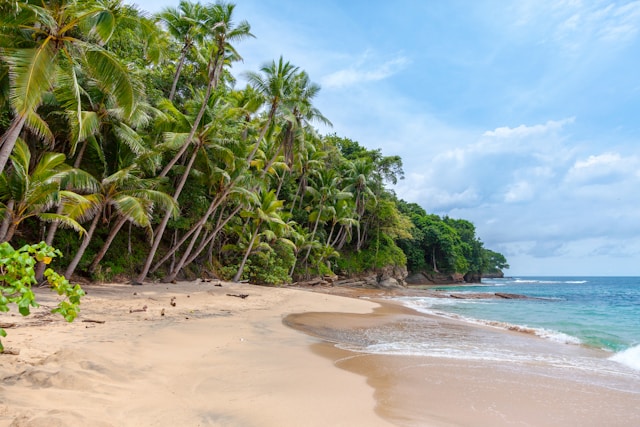The Canary Islands are a magnet for adventurers, thrill-seekers, and lovers of all things ocean. With year-round sunshine, steady trade winds, and crystal-clear waters, the archipelago offers a dream playground for water sports enthusiasts. Whether you’re into surfing, windsurfing, paddleboarding, or scuba diving, the Canary Islands beaches deliver unforgettable aquatic experiences across every island.
1. Playa de Famara – Lanzarote’s Surfing Paradise
Playa de Famara stretches along Lanzarote’s northwest coast, backed by majestic cliffs and facing strong Atlantic swells. It’s the ultimate surf destination in the Canaries, welcoming both beginners and experienced riders. The consistent waves and laid-back village atmosphere make it a favorite among surfers, kiteboarders, and bodyboarders.
Best for: Surfing, kiteboarding, bodyboarding
Facilities: Surf schools, rentals, cafes in Caleta de Famara
Pro tip: Visit in winter for the biggest waves and a more vibrant surf scene.
2. El Médano – Tenerife’s Windsurfing Capital
Known worldwide for its ideal wind conditions, El Médano in southern Tenerife is the Canary Islands’ windsurfing and kitesurfing capital. The strong and steady trade winds make it perfect for adrenaline junkies. You’ll find several water sports schools, rental shops, and international competitions throughout the year.
Best for: Windsurfing, kitesurfing, wing foiling
Atmosphere: Youthful, energetic, with a bohemian vibe
Bonus: Safe, shallow bay area ideal for beginners
3. Playa de Sotavento – Fuerteventura’s Kiteboarding Icon
Playa de Sotavento is famous for its lagoon that forms during low tide—a kitesurfer’s dream. Located on the Jandía Peninsula in Fuerteventura, it hosts several international kiteboarding and windsurfing events annually. With wide open spaces and warm water, it’s ideal for all skill levels.
Best for: Kitesurfing, windsurfing
Why go: Flat-water lagoon and consistent winds
Tip: Time your visit with low tide for maximum space and safety
4. Las Canteras Beach – Gran Canaria’s Snorkeling and SUP Haven
Las Canteras in Las Palmas de Gran Canaria is more than just a city beach—it’s a snorkeling and paddleboarding gem. Protected by a natural reef (La Barra), the calm waters make it ideal for stand-up paddleboarding, kayaking, and spotting marine life just beneath the surface.
Best for: Snorkeling, SUP, kayaking
Highlight: Great urban beach with clear water
Facilities: Easy access to rentals, instructors, and restaurants
5. La Cicer – Gran Canaria’s Surf Spot for All Levels
Located on the western end of Las Canteras, La Cicer is Gran Canaria’s go-to beach for surfing. With surf schools and consistent waves, it’s ideal for both beginners and intermediates. The black volcanic sand and vibrant beachfront community add to its charm.
Best for: Surfing (beginner to intermediate)
Vibe: Sporty and sociable
Bonus: Night surf sessions and local competitions
6. Playa Blanca – Lanzarote’s Jet Ski and Parasailing Hub
While Playa Blanca is known for its relaxed ambiance, it’s also a hub for motorized water sports. Jet skiing, parasailing, banana boat rides, and glass-bottom boat tours are all available along the beach. It’s great for families or travelers looking for thrills in comfort.
Best for: Jet skiing, banana boats, parasailing
Good for: First-timers and families
Services: Multiple water sports operators on the promenade
7. Playa del Inglés – Gran Canaria’s Aquatic Playground
Playa del Inglés is one of Gran Canaria’s most popular tourist beaches and offers everything from jet skis to banana boats, pedalos, and parasailing. It’s perfect for those who want water sports without venturing too far from their hotel.
Best for: All-around water sports fun
Scene: Lively, accessible, great for groups
Extra: Calm areas also suitable for swimming and beach games
8. Playa de Corralejo – Fuerteventura’s Multisport Coastline
Just steps from the dunes of Corralejo Natural Park, Playa de Corralejo offers water sports for everyone. The beach is a launchpad for surfing, kiteboarding, windsurfing, and scuba diving. Corralejo town is filled with surf shops and dive schools, making it a top destination for active travelers.
Best for: Multi-sport adventurers
What’s special: Strong community of surfers and divers
Don’t miss: Boat trips to Isla de Lobos for diving and snorkeling
9. Playa de Abades – Tenerife’s Diving Hotspot
In southeastern Tenerife, Playa de Abades is a lesser-known gem that’s gained fame as a diving and snorkeling spot. The bay is calm and clear, with underwater volcanic structures and marine biodiversity. Whether you’re new to scuba or want a relaxed snorkeling session, this beach is perfect.
Best for: Scuba diving, snorkeling
Conditions: Calm waters, ideal for underwater photography
Nearby: Dive centers offering guided experiences
Conclusion: Your Ultimate Water Sports Escape
From surfing giant Atlantic swells in Lanzarote to paddleboarding through calm city waters in Gran Canaria, the Canary Islands beaches offer something for every water sports lover. With their volcanic landscapes, consistent climate, and world-class facilities, it’s no surprise these islands are ranked among Europe’s top aquatic destinations.
Whether you’re seeking the wind in your sail, a board under your feet, or the serenity of underwater exploration, there’s a perfect beach waiting for you in the Canaries.
Pack your gear, book your flights, and dive into a world of water sports in one of the most dynamic island groups on the planet.
FAQs
1. What’s the best time to visit the Canary Islands for water sports?
The islands are a year-round destination, but the best conditions for surfing and windsurfing are from October to March, while summer offers calmer seas ideal for snorkeling, SUP, and diving.
2. Can beginners enjoy water sports on Canary Islands beaches?
Absolutely. Beaches like El Médano, La Cicer, and Las Canteras have calm areas, certified instructors, and beginner-friendly conditions. Many schools offer introductory classes and equipment rental.
3. Are water sports safe in the Canary Islands?
Yes—safety standards are high, and most beaches have lifeguards and well-regulated operators. Still, always check conditions and go with a guide or certified school if you’re a beginner.
4. Do I need to bring my own gear?
While some enthusiasts prefer their own equipment, most beaches offer rentals for surfboards, kites, wetsuits, jet skis, and more. Dive centers also provide full gear for scuba and snorkeling trips.
5. Which island is best overall for water sports?
Fuerteventura and Tenerife stand out for variety. Fuerteventura excels in wind-based sports, while Tenerife offers surfing, diving, and more. Gran Canaria and Lanzarote are also excellent, each with their own specialties.
Also read : South Coast England Map: Explore the Best Coastal Towns, Beaches & Routes




Leave a Comment